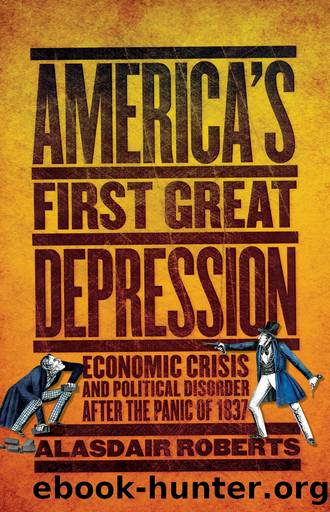America's First Great Depression by Alasdair Roberts

Author:Alasdair Roberts [Roberts, Alasdair]
Language: eng
Format: epub
Tags: History, United States, 19th Century
ISBN: 9780801464676
Google: ocDwdZenr18C
Publisher: Cornell University Press
Published: 2012-04-15T22:25:35+00:00
CHAPTER 4
Law and Order
The First Great Depression began as a crisis among financial institutions and then effloresced into something larger and more complicated. Economic troubles led to political turmoil. The machinery of state and federal government strained to manage a welter of old and new antagonismsâbetween sections, between parties, between debtors and creditors, between Americans and Britons. Voting rates surged, the duration of incumbency for officeholders became more uncertain, tempers frayed, and the capacity for conciliation declined. The countryâs nascent democratic institutions were like the boiler on a steamboat. Could the pressures within those institutions be regulated and contained, or would the whole system blow apart, as did steamboats on the Hudson and Mississippi with lamentable regularity?
The fear that political troubles might end in violence was real and well-justified. In cities and on farms across the country, economic decline awakened old grievances about inequities in the distribution of economic and political power. In good times, when farmers and workers were doing well, these complaints might be put aside. In bad times they acquired new force, and disgruntled Americans were organized more easily to push for change. These early protests were often garbed in the language and symbolism of the Revolutionary War. Many took the idea of revolution seriously, offering violent resistance to the status quo. This was most clearly the case in the northeastern United States, where agrarian and industrial laborers, not shackled by the institution of slavery, had the capacity to organize and articulate their grievances.
At the time, these uprisings were widely regarded as symptoms of a sickness within the American polity. The violence raised questions about the capacity of citizens to regulate themselves, and also about the ability of a nation organized on democratic principles to maintain civil peace. Here was the basic problem of the crisisâthe balancing of liberty and orderâpresented in its barest form. And once again domestic and international affairs became entangled, as creditors in Europe wondered whether they could trust their investments to a land in which peace could not be maintained. Authorities in three states that experienced severe outbreaks of violence responded to this challenge in similar ways. Tentative attempts to maintain order eventually gave way to the ruthless suppression of resistance against established authority. Law and order had to be preserved, and if the governmental capability to maintain order did not exist, it had to be created. One of the essential requirements for the survival of a fragile, open economy proved to be the availability of an effective domestic police power.
Download
This site does not store any files on its server. We only index and link to content provided by other sites. Please contact the content providers to delete copyright contents if any and email us, we'll remove relevant links or contents immediately.
Zero to IPO: Over $1 Trillion of Actionable Advice from the World's Most Successful Entrepreneurs by Frederic Kerrest(4249)
Machine Learning at Scale with H2O by Gregory Keys | David Whiting(4132)
Never by Ken Follett(3772)
Harry Potter and the Goblet Of Fire by J.K. Rowling(3763)
Ogilvy on Advertising by David Ogilvy(3490)
Shadow of Night by Deborah Harkness(3282)
The Man Who Died Twice by Richard Osman(2984)
Book of Life by Deborah Harkness(2858)
0041152001443424520 .pdf by Unknown(2777)
Will by Will Smith(2777)
My Brilliant Friend by Elena Ferrante(2764)
The Tipping Point by Malcolm Gladwell(2749)
How Proust Can Change Your Life by Alain De Botton(2732)
Purple Hibiscus by Chimamanda Ngozi Adichie(2635)
How to Pay Zero Taxes, 2018 by Jeff A. Schnepper(2582)
Hooked: A Dark, Contemporary Romance (Never After Series) by Emily McIntire(2487)
Rationality by Steven Pinker(2282)
Borders by unknow(2219)
Can't Hurt Me: Master Your Mind and Defy the Odds - Clean Edition by David Goggins(2178)
